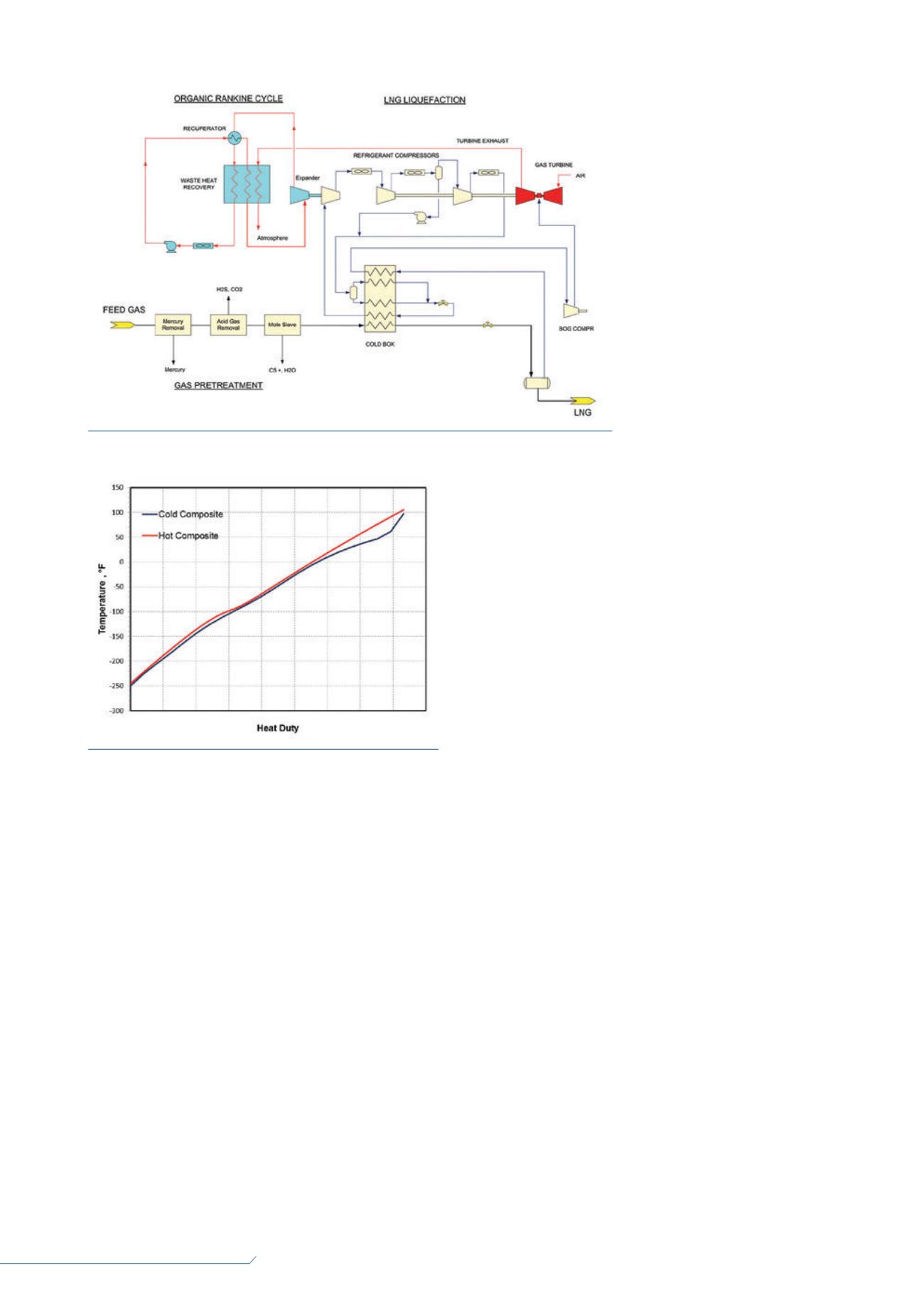
46
LNG
INDUSTRY
MARCH
2016
Small and mid scale liquefaction facilities typically utilise
simpler refrigeration systems than large baseload facilities
using single mixed refrigerant (SMR) or gas expander (using
nitrogen, methane or a mixture of both) processes. The mixed
refrigerant (MR) cycles are typically more energy efficient,
whereas the gas expander cycles are simple and robust.
For plants using gas turbines to drive refrigeration
compressors, waste heat is typically recovered by either hot
oil systems and/or steam generation to supply heat and/or
power in the LNG complex. Steam generation can be
complex and costly for smaller plants. Small to mid scale
LNG plants can be lower in thermal efficiency and higher in
carbon emissions per unit of LNG produced, relative to
world-scale facilities.
The Organic Rankine Cycle (ORC) is a thermodynamic
cycle based on the classic Rankine cycle using an organic
working fluid. ORC power plants have been proven in
geothermal applications for power generation, but have not
been applied to LNG liquefaction plants. Fluor has developed
small to mid scale SMR and expander processes by
integrating an ORC to recover waste heat from a gas turbine
driver, producing designs that are energy efficient and cost
competitive.
1,2
These schemes are
the subject of this article.
Gas
pretreatment
Feed gas to an LNG liquefaction
plant requires removal of the
C
5+
components to less than
0.05 mol% and aromatics to ppm
levels. With lean US pipeline gas,
the use of a conventional scrub
column may not meet liquefaction
unit gas specifications. The use
of cryogenic separation may be
feasible, but at an incremental
cost. A viable solution can be the
use of the large pore molecular
sieves, which can simultaneously
adsorb water, aromatics and C
5+
components.
3
For lean gas, the
C
5+
content and aromatics may
be removed sufficiently to avoid waxing in the cold box. For
a low quantity of heavy hydrocarbons, the use of a molecular
sieve is an economical option over conventional processes.
Prior to the molecular sieve unit, the feed gas must be
treated in an acid gas removal unit (AGRU) to meet the CO
2
and H
2
S specifications. It must also be processed in a mercury
removal bed to meet specifications required to avoid mercury
corrosion in the downstream heat exchangers.
3,4
Organic Rankine Cycle
Rankine Cycles are used in steam cycle power plants. Instead
of steam, the cycle can also be operated using hydrocarbons
as the working fluid. The selection of the working fluid is
based on its condensation temperature, using ambient air
or cooling water as the cooling medium. The ORC power
cycle is illustrated in Figure 1. The condensed working fluid
is pumped to a high pressure (typically 600 psig), vaporised
and superheated using hot gas turbine exhaust. A recuperator
is used to recover the waste heat from the expanded gas,
increasing the cycle’s thermal efficiency. The high pressure
working fluid is then expanded in an expander to generate
power for the LNG plant. The working fluid is condensed and
pumped, and the cycle is repeated.
In cold climate operation, the ORC plant has an
advantage over a steam plant in that the organic fluid can
operate at a lower pressure, generating more power, without
the water freezing problems in a steam plant.
The thermal efficiency of a typical gas turbine is
approximately 36 – 40%. Therefore, ~60% of the heat
content is lost in the exhaust gas. The ORC plant, similar to a
steam plant, can achieve approximately 25% thermal
efficiency. The net result is a 35% higher power output per
Btu of fuel gas consumed in the gas turbine. The extra power
from the ORC can be used to drive the refrigeration
compressor or for power generation. This results in a
reduction in fuel consumption or an increase in LNG
production.
For the less efficient gas turbine drivers, it can be prudent
to recover the waste heat to reduce energy consumption and
CO
2
emissions.
Figure 1.
ORC – SMR LNG liquefaction.
Figure 2.
Composite heat curve for SMR liquefaction process.


